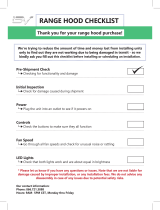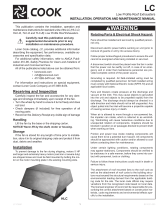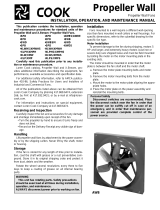Page is loading ...

PHR
Axial Flow Hooded Roof Ventilators
Revised: 08/24/15OPERATION & MAINTENANCE
The information contained herein is, to the best of our knowledge, accurate and applicable for proper operation and installation of
the specied equipment at the time this document entered service. Before proceeding, it is recommended that you check for a more
current version of this Installation Operation Manual (IOM) on our website at www.johnsoncontrols.com.
Read carefully before attempting to assemble, install, operate or maintain the product described. Protect yourself and others by
observing all safety information. Failure to comply with instructions could result in personal injury and/or property damage! Retain
instructions for future reference.
IMPORTANT!
READ BEFORE PROCEEDING!

JOHNSON CONTROLS2
RECEIVING AND HANDLING
YORK® by Johnson Controls fans are carefully inspected
before leaving the factory. When the unit is received, inspect
for any signs of tampering. Inspect the unit for any damage that
may have occurred during transit and check for loose, missing
or damaged parts. Mishandled units can void the warranty
provisions. YORK® by Johnson Controls is not responsible for
damages incurred during shipment.
Avoid severe jarring and/or dropping. Handle units with care to
prevent damage to components or special nishes.
STORAGE
Long-term storage requires special attention. Units should be
stored on a level, solid surface, preferably indoors. If outside
storage is necessary, protect the units against moisture and dirt
by encasing in plastic or some similar weatherproof material.
Periodically inspect units and rotate wheel to spread bearing
lubricant. If unit will be stored for extended time, remove belts.
INSTALLATION
Installing the Dampers
When required, install dampers prior to mounting the unit on the
curb or frame. Secure dampers to the inside of the curb without
undue twisting, which may distort the damper frame. Damper
frame must be reasonably level on all sides. Check for free
operation. If dampers are motor operated type, ascertain that
proper voltage is impressed on motor terminals.
Positioning and Running Power Lines
When power lines are brought up to the unit, provide a generous
amount of slack to allow for motor deections and to permit
movement of motor for belt tension adjustments. Ground motor
adequately and securely. Protect power lines from sharp objects.
Do not kink power line or permit it to contact hot surfaces,
chemicals, grease or oil. Use only UL recognized electrical
parts, rated for proper voltage, load and environment.
Power is normally brought from within the building and placed
inside one corner of the curb. Feed power line through the
clearance hole provided in the damper and in turn through the
ventilator to the disconnect switch, if furnished, and motor.
Anchoring or Securing the Unit
Whenever possible, anchor the fan by fastening through the
vertical portion of the mounting ange. The type, size and number
of fasteners depends upon the unit size and curb construction.
If code or specication prescribes fastening through the top
(horizontal portion) of the mounting ange, use neoprene or lead
washers under the head of each fastener to prevent water leaks.
Guy down large units installed in areas subject
to high winds or unusual eld conditions.
If the contractor removes ventilator parts to facilitate installation
and electrical connections, all parts should be reassembled
by replacing all spacers, washers, nuts, bolts, fasteners and
components exactly as they were found prior to removal. All
fasteners are to be drawn tight and secure. The ventilator is now
ready for service.
START-UP AND OPERATION
Carefully inspect the unit before start-up. All motor fasteners
should be securely tightened. Propeller should be rotated by
hand to insure free movement. (NOTE: Before placing hand on
propeller or belts, lock out power source.) Check all set-screws
and keys. Tighten when necessary.
Check the condition of belts and the amount of tension prior
to start-up. DO NOT over tighten, as bearing damage will occur.
Recommended belt tension should permit deection of 1/64” of
the belt on each side of the belt measured halfway between the
pulley centerline. Exercise extreme care when adjusting belts
as not to misalign the pulleys. Any misalignment will cause a
sharp reduction in belt life an produce squeaky, annoying noises.
On units equipped with two or three groove pulleys, adjustments
must be made so that there is equal tension on all belts.
Whenever belts are removed or installed, never
force belts over pulleys without loosening motor
rst to relieve belt tension.
INTRODUCTION, INSTALLATION,
START-UP AND OPERATION
FIGURE 1: PULLEY ALIGNMENT & TENSION

JOHNSON CONTROLS 3
Make sure inlets and approaches to the unit are free from
obstruction. Before putting fan into operation, complete the
following checklist:
1. Turn off power source.
2. Make sure installation is in accordance with
manufacturer’s instructions.
3. Check and tighten all fasteners.
4. Spin centrifugal wheel to see if rotation is free.
5. Check all set-screws and keys tighten if necessary.
6. Check belt for alignment (use recommended belt tension
gauges).
7. Check belt for proper sheave selection.
8. Make sure there is no foreign, loose material in ductwork
leading to and from fan or in the fan itself.
9. Properly secure all safety guards.
10. Secure all access doors to fan an ductwork.
11. Check line voltage with motor nameplate.
12. Check wiring.
On single phase motors, the terminal block must
be set up in accordance with the nameplate
instructions and/or wiring diagram. This set
up must match the line voltage. If the motor is
multi-speed or multi-voltage, the winding leads
must be grouped and connected as shown on the
motor wiring diagram. The line voltage must
correspond with proper grouping of motor leads. The wiring
diagram must be followed explicitly or serious motor or starter
damage will occur.
Switch on electrical supply and allow fan to reach full speed.
Check carefully for:
1. Correct rotation of the propeller.
Incorrect rotation overloads motor severely and
results in serious motor damage. To change
rotation of three phase units, interchange any
2 of the 3 line leads. On single phase units,
change the terminal block set-up following the
wiring diagram on the motor.
2. Check motor and bearing temperatures for excessive heat.
Use care when touching the exterior of an
operating motor. Modern motors normally run
hot. They are designed to operate at higher
temperatures. This is a normal condition
but they may be hot enough to be painful or
injurious to the touch.
If any problem is indicated, TURN OFFPOWER TO UNIT
IMMEDIATELY. Lock out the electrical supply, check carefully
for the cause of the trouble and correct as needed. Even if the
fan appears to be operating satisfactorily, shut down after a brief
period and check all fasteners, set-screws and keys for tightness.
During the rst eight (8) hours of operation, check the fan
periodically for excessive vibration or noise. At this time, also
check motor input current and motor bearing temperatures to
insure that they do not exceed manufacturer’s recommendations.
After eight (8) hours of satisfactory operation, shut down the fan
and lock out the electrical power to check the following items
and adjust if necessary:
1. All set-screws, keys and fasteners.
2. Drive coupling alignment.
3. Belt alignment.
4. Belt tension.
NOTE: Take care to follow all local electrical, safety and building codes. Follow
provisions of the National ElectricalCode as well as the Occupational Safety and
Health Act.
Always disconnect power source before working on the unit.
Guard and protect all moving parts.
All motors are checked prior to shipment. However, if motor
defects should develop, prompt service can be obtained from
the nearest authorized service station of the motor manufacturer
under the warranty. Exchange, repair or replacement will be
provided on a no charge basis if the motor is defective within
the warranty period. Do not return defective motors.
WARNING: Motor guarantee is void unless overload
protection is provided in motor wiring circuit.
START-UP AND OPERATION (CONTINUED)

JOHNSON CONTROLS4
MAINTENANCE
Do not attempt maintenance on a fan until the electrical supply
has been completely disconnected. Lubrication is a primary
maintenance responsibility. Check all bearings periodically.
Inspect belts for tightness. If the fan is installed in a corrosive or
dirty atmosphere, periodically clean the centrifugal wheel, inlet,
motor housing and other moving parts.
Fan Shaft Lubrication
Fan shaft bearing pillow blocks are furnished in either the pre-
lubricated sealed-for-life type or the greasable type depending on
what was ordered. The pre-lubricated type requires no servicing
for 7 to 10 years of normal use and the greasable type are factory
greased eliminating the need for greasing initially. Follow the
lubricating schedule recommended by the factory. This practice
should not supersede any safety considerations.
Use low pressure grease guns only. High
pressure guns tend to blow out or unseat bearing
seals, leaving the bearing open to collect grime,
dust and foreign particles.
Lubrication Schedule
1. Under average conditions where ambient temperatures do
not exceed 120°F, lubrication is required 1 to 2 times a year.
2. Under dirt laden atmosphere where there is a temperature
range of 120°F to 150°F, lubrication is required from 3 to 6
times a year.
3. Under extreme temperature conditions and extremely dirty
atmospheres, lubrication should be scheduled at least once
or twice a month.
4. Belt driven units maximum temperature should not exceed
160°F. Direct driven models have temperature range
stamped on motor.
Motor Lubrication
In general, standard motors are furnished with prelubricated,
sealed-for-life ball bearings which require no lubrication for 7
to 10 years of normal service. Where motors have been ordered
with greasable bearings, these bearings are factory lubricated
and require no attention for one year under normal conditions. If
grease relief ttings are provided, remove them when performing
maintenance to allow grease to ow out. Whenever possible,
apply grease while the motor is running. This practice should not
supersede any safety considerations. DO NOT OVER GREASE,
as most lubricants deteriorate motor windings, thereby reducing
motor life and presenting a re hazard.
HIDDEN DANGER
In addition to the normal dangers of rotating machinery, fans
present an additional hazard in their ability to suck in not only
air, but loose material as well. Solid objects can pass through the
fan and be discharged by the impeller as potentially dangerous
projectiles. Therefore, screen intake to ductwork, whenever
possible, to prevent the accidental entrance of solid objects.
Never open access doors to a duct system with the fan running.
When starting the fan for the rst time, completely inspect the
ductwork and interior of the fan (with the power locked off), to
make certain there is no foreign material which can be sucked
into or blown through the ductwork.
Where the fan is accessible to untrained personnel or the general
public, use maximum safety guards, even at the cost of some
perfomance loss.
Unprotected fans located less than 7’ above the
oor also require guarding as specied in the
Occupational Safety and Health Act (OSHA).
TABLE 1: RECOMMENDED LUBRICANTS
Manufacturer Product Temperature Range
BP LG-#P-1
Below 32°F
(0°C)
Gulf Gulfcrown EP-1
Imperial Oil Unirex EP-1
Shell Alvania R-1
BP Energrease MPMK11
32°F to 150°F
(0°C to 66° C)
Gulf Gulfcrown EP-2
Imperial Oil Unirex EP-2
Shell Alvania R-3
Sun Oil Sun Prestige 42
Texaco Regal AFB2
MAINTENANCE AND HIDDEN DANGER

JOHNSON CONTROLS 5
GUARDS, SPECIAL PURPOSE SYSTEMS,
AND PARTS REPLACEMENT
GUARDS
All fans have moving parts which require guarding in the same
way as other moving machinery. In areas which are accessible
only to experienced personnel, a standard industrial type guard
may be adequate. This type of guard will prevent the entry of
thrown or dropped objects with a minimum restriction of air
ow.
Axial fans may be connected directly to ductwork which will
prevent contact with the internal moving parts, but when the
inlet or outlet is exposed, install a suitable guard. Accordingly,
roof openings for YORK® by Johnson Controls Axial units can
be easily and neatly tted with framed safety guards. YORK®
by Johnson Controls recommends the use of guards on all
exposed non-ducted fans, ceiling and wall mounted.
Fans may be driven from the motor shaft or through a belt drive.
In every case where the bearing assembly, rotating shaft, sheaves
or belts are exposed, a suitable guard should be provided.
SPECIAL PURPOSE SYSTEMS
Explosive, corrosive, high temperatures, etc. may require
special construction, inspection and maintenance. It is necessary
to observe the fan manufacturer’s recommendations and
limitations concerning the type of material to be handled by the
fan and its application to special conditions.
PARTS REPLACEMENT
If replacing parts, do so with properly selected components
which duplicate the original parts correctly. Incorrectly sized
shafts, belts, pulleys, centrifugal wheels, etc. can damage the
fan.

JOHNSON CONTROLS6
TROUBLESHOOTING CHECKLIST
Note: Care should be taken to follow all local electrical, safety and building codes. Provisions of the National Electric Code (NEC), as wells as the Occupational Safety and
Health Act (OSHA) should be followed.
All motors are checked prior to shipment. If motor defects should develop, prompt service can be obtained from the nearest
authorized service station of the motor manufacturer while under warranty. Exchange, repair or replacement will be provided on a
no charge basis if the motor is defective within the warranty period. The YORK® by Johnson Controls representative in your area
will provide a name and address of an authorized service station if requested.
WARNING: Motor guarantee is void unless overload protection is provided in motor wiring circuit.
Symptom Possible Cause(s) Corrective Action
Excessive
Noise
1. Defective or loose motor bearings.
2. Ventilator base not securely anchored.
3. Loose or unbalanced wheel/propeller.
4. Misaligned pulleys or shaft.
5. Loose or damaged wheel/propeller.
6. Wheel running in wrong direction.
1. Replace motor with same frame size, RPM, HP.
2. Reset properly.
3. Tighten screws, remove build-up, balance wheel/
propeller.
4. Correct alignment.
5. Replace wheel/propeller.
6. Reverse direction.
Fan
Inoperative
1. Blown fuse or open circuit breaker.
2. Loose or disconnected wiring.
3. Defective motor.
4. Broken belts.
1. Replace fuses or circuit breaker.
2. Shut off power and check wiring for proper connections.
3. Repair or replace motor.
4. Replace belts.
Insufcient
Airow
1. Open access doors or loose sections of ducts.
2. Clogged lters.
3. Operation in wrong direction.
4. Insufcient make-up air direction.
1. Check for leakage.
2. Clean lters.
3. Correct rotation of wheel/propeller.
4. Add make-up fan or louver opening.
Water Leaking
into Ductwork
or Collection of
Grease Under Fan
1. Fan installed with slope in the wrong direction.
2. Clogged drain spout.
3. Cooling tube or motor dome top removed.
4. Grease container full.
1. Slope should be tted in the direction of the drainage
opening or grease collection box and drain spout.
2. Clean drain spout.
3. Install new cooling tube with gasket and dome top.
4. Empty grease box.
Motor
Overheating
1. Belt slippage.
2. Overvoltage or under voltage.
3. Operation in wrong direction.
4. Fan speed too high.
5. Incorrect motor (service factor 1.0, low ambient
temperature).
6. Blocked cooling tube or leaky gasket.
7. Insufcient airow to kitchen hood fan operating
on low speed with kitchen in full operation.
8. Undersized motor.
1. Adjust tension or replace bad belts.
2. Contact power supply company.
3. Reverse direction of motor.
4. Slow down fan by opening variable pitch pulley on motor
shaft.
5. Replace motor with correct open, NEMA service factors
(1.15 or higher) with 40 degrees ambient.
6. Remove blockage and seal cooling tube in place.
7. Check airow under hood and adjust kitchen equipment
output.
8. Check motor ratings with catalog speed and air capacity
chart.

JOHNSON CONTROLS 7
NOTES

P.O. Box 1592, York, Pennsylvania USA 17405-1592
Copyright © by Johnson Controls 2015
Revised: 08/24/15
Tele. 800-861-1001
www.york.com
For Product Warranty Support and Parts call 814-479-4005
Subject to change without notice. Printed in USA
ALL RIGHTS RESERVED
/


